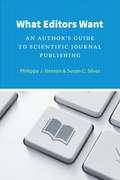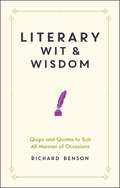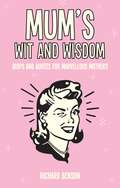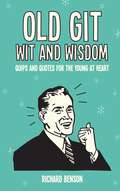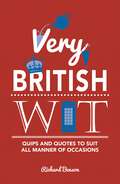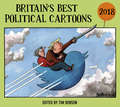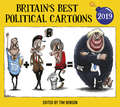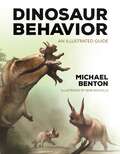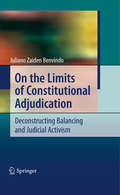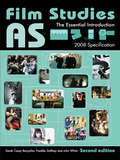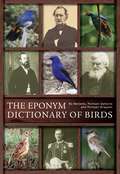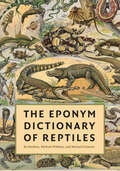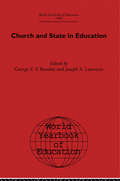- Table View
- List View
What Editors Want: An Author's Guide to Scientific Journal Publishing (Chicago Guides to Writing, Editing, and Publishing)
by Philippa J. Benson Susan C. SilverResearch publications have always been key to building a successful career in science, yet little if any formal guidance is offered to young scientists on how to get research papers peer reviewed, accepted, and published by leading scientific journals. With What Editors Want, Philippa J. Benson and Susan C. Silver, two well-respected editors from the science publishing community, remedy that situation with a clear, straightforward guide that will be of use to all scientists. Benson and Silver instruct readers on how to identify the journals that are most likely to publish a given paper, how to write an effective cover letter, how to avoid common pitfalls of the submission process, and how to effectively navigate the all-important peer review process, including dealing with revisions and rejection. With supplemental advice from more than a dozen experts, this book will equip scientists with the knowledge they need to usher their papers through publication.
What Editors Want: An Author's Guide to Scientific Journal Publishing (Chicago Guides to Writing, Editing, and Publishing)
by Philippa J. Benson Susan C. SilverResearch publications have always been key to building a successful career in science, yet little if any formal guidance is offered to young scientists on how to get research papers peer reviewed, accepted, and published by leading scientific journals. With What Editors Want, Philippa J. Benson and Susan C. Silver, two well-respected editors from the science publishing community, remedy that situation with a clear, straightforward guide that will be of use to all scientists. Benson and Silver instruct readers on how to identify the journals that are most likely to publish a given paper, how to write an effective cover letter, how to avoid common pitfalls of the submission process, and how to effectively navigate the all-important peer review process, including dealing with revisions and rejection. With supplemental advice from more than a dozen experts, this book will equip scientists with the knowledge they need to usher their papers through publication.
What Editors Want: An Author's Guide to Scientific Journal Publishing (Chicago Guides to Writing, Editing, and Publishing)
by Philippa J. Benson Susan C. SilverResearch publications have always been key to building a successful career in science, yet little if any formal guidance is offered to young scientists on how to get research papers peer reviewed, accepted, and published by leading scientific journals. With What Editors Want, Philippa J. Benson and Susan C. Silver, two well-respected editors from the science publishing community, remedy that situation with a clear, straightforward guide that will be of use to all scientists. Benson and Silver instruct readers on how to identify the journals that are most likely to publish a given paper, how to write an effective cover letter, how to avoid common pitfalls of the submission process, and how to effectively navigate the all-important peer review process, including dealing with revisions and rejection. With supplemental advice from more than a dozen experts, this book will equip scientists with the knowledge they need to usher their papers through publication.
Dad's Wit and Wisdom: Quips and Quotes for Fantastic Fathers
by Richard BensonWhen your precious offspring have hijacked the car and there’s a hole in your wallet the size of the Grand Canyon, kick back and relax with this hilarious book, crammed full of quips and quotes to remind you why being a dad is the best job in the world.
Grandad's Wit and Wisdom: Quips and Quotes for Glorious Grandpas
by Richard BensonWhen your roses have been trampled by little feet and the golf has been hijacked by children’s TV, reach for this hilarious book, crammed full of quips and quotes to remind you why being a grandad is one of the best jobs in the world.
Grandma's Wit and Wisdom: Quips and Quotes for the Greatest Grannies
by Richard BensonWhen there are sticky handprints on the sofa and you can’t prise the darlings away from a screen, reach into your handbag for this hilarious book, crammed full of quips and quotes to remind you why being a grandma is one of the best jobs in the world.
Irish Wit and Wisdom: Quips and Quotes to Suit All Manner of Occasions
by Richard BensonWith quips, quotes and insults – from classic favourites W. B. Yeats and Oscar Wilde, to modern greats including Seamus Heaney and Spike Milligan – this excellent selection ensures that the perfect Irish witticism will always be on the tip of your tongue, and celebrates the very essence of Ireland.
Literary Wit and Wisdom: Quips and Quotes to Suit All Manner of Occasions
by Richard BensonWith quips, quotes and insults from beloved classic literary writers such as William Shakespeare to modern literati Zadie Smith, Literary Wit will ensure that you’re never at a loss for the perfect witticism.
Mum's Wit and Wisdom: Quips and Quotes for Marvellous Mothers
by Richard BensonWhen the little angels are driving you crazy and you’re one minivan away from being a personal taxi service, these wonderful quips and quotes will help to remind you that being a mum is the best job in the world.
Old Git Wit and Wisdom: Quips and Quotes for the Young at Heart
by Richard BensonSo you’re getting on a bit, but even if your body creaks more than it used to, you’ve still got your sense of humour. This collection of witty quotations and gems of senior sagacity will keep a spring in your step and the cobwebs at bay.
Very British Wit: Quips and Quotes to Suit All Manner of Occasions
by Richard BensonWith quips, quotes and insults from classic favourites William Shakespeare and Jane Austen to modern humorists Stephen Fry and Billy Connolly, this delightful book will ensure you’re never at a loss for the perfect witticism.
Britain’s Best Political Cartoons 2018
by Tim Benson____________A blockbuster collection of the year’s funniest political cartoons, featuring the work of Mac, Steve Bell, Peter Brookes and many more . . . 2018 was the year that Brexit got serious, royals got married, football got (briefly) feverish, and Trump got transformed into a giant baby blimp. In Britain’s Best Political Cartoons 2018, our very finest satirists turn their eyes and their pens to all these events and more, offering an incisive and often hilarious tour through a tumultuous twelve months.
Britain’s Best Political Cartoons 2019
by Tim BensonA hilarious companion to the year’s political turmoil, featuring the work of Martin Rowson, Steve Bell, Peter Brookes, Nicola Jennings and many more . . . 2019 was the year of Brexit, obviously. But it was also the year that Donald Trump went haywire over Huawei, Nigel Farage met his match (a milkshake), Theresa May got bounced by the backstop, and Boris Johnson was hoisted into high office. In Britain’s Best Political Cartoons 2019, our very finest satirists skewer everything from Kremlin collusion to no-deal confusion, offering a riotous ride through the last twelve months. And did we mention Brexit?
A Teaching Assistant's Guide to Managing Behaviour in the Classroom
by Susan BenthamA practical and authoritative guide to common behaviour problems in the classroom, this book explaines typical causes of misbehaviour and shows what teaching assistants can do to calm disruptive children. Using a range of case studies discussed from a teaching assistant's perspective, Susan Bentham explores: the role of the teaching assistant in relation to school behaviour policies when and how to reward good behaviour why we need to understand the reason for bad behaviour in order to deal with it how to implement behaviour strategies that really work. Mirroring the course content of most teaching assistant GNVQ and Foundation degree qualifications, Bentham highlights how practitioners can learn from their experiences and develop new skills and coping strategies, which will free them up to concentrate on the most important part of the job: supporting learning. In an expanding market, this guide is a must-buy for any teaching assistant finding that disrupted classrooms are becoming their biggest challenge.
A Teaching Assistant's Guide to Managing Behaviour in the Classroom
by Susan BenthamA practical and authoritative guide to common behaviour problems in the classroom, this book explaines typical causes of misbehaviour and shows what teaching assistants can do to calm disruptive children. Using a range of case studies discussed from a teaching assistant's perspective, Susan Bentham explores: the role of the teaching assistant in relation to school behaviour policies when and how to reward good behaviour why we need to understand the reason for bad behaviour in order to deal with it how to implement behaviour strategies that really work. Mirroring the course content of most teaching assistant GNVQ and Foundation degree qualifications, Bentham highlights how practitioners can learn from their experiences and develop new skills and coping strategies, which will free them up to concentrate on the most important part of the job: supporting learning. In an expanding market, this guide is a must-buy for any teaching assistant finding that disrupted classrooms are becoming their biggest challenge.
Trade Marks And Brands: An Interdisciplinary Critique (Cambridge Intellectual Property And Information Law Ser. (PDF) #10)
by Lionel Bently Jennifer Davis Jane C. GinsburgDevelopments in trade marks law have called into question a variety of basic features, as well as bolder extensions, of legal protection. Other disciplines can help us think about fundamental issues such as: what is a trade mark? What does it do? What should be the scope of its protection? This volume assembles essays examining trade marks and brands from a multiplicity of fields: from business history, marketing, linguistics, legal history, philosophy, sociology and geography. Each chapter pairs lawyers' and non-lawyers' perspectives, so that each commentator addresses and critiques his or her counterpart's analysis. The perspectives of non-legal fields are intended to enrich legal academics' and practitioners' reflections about trade marks, and to expose lawyers, judges and policy-makers to ideas, concepts and methods that could prove to be of particular importance in the development of positive law.
Dinosaur Behavior: An Illustrated Guide
by Michael J. BentonA stunningly illustrated guide to these extraordinary creatures from a world-renowned paleontologistPaleobiology has advanced from a speculative subject to a cutting-edge science. Today, researchers are applying the latest forensic technologies to the fossil record, revealing startling new insights into the lives of dinosaurs. This illustrated guide explores the behavior, evolution, physiology, and extinction of dinosaurs, taking readers inside the mysterious world of these marvelous animals. With specially commissioned illustrations by Bob Nicholls, Dinosaur Behavior explains how the dinosaurs lived and courted, fought and fed, signaled and interacted with each other, and much more.Features a wealth of breathtaking illustrations throughoutOffers new perspectives on the prehistoric world inhabited by dinosaursSheds light on how dinosaurs actually looked, how they moved, and how fast they ranExplains the feeding habits of carnivores, herbivores, scavengers, and solitary huntersDiscusses sight, hearing, smell, spatial orientation, and intelligenceBrings to life the social behavior of dinosaurs, from mating and parenting to herd dynamics and migrationTakes readers behind the scenes of the latest, most thrilling discoveries
Dinosaur Behavior: An Illustrated Guide
by Michael J. BentonA stunningly illustrated guide to these extraordinary creatures from a world-renowned paleontologistPaleobiology has advanced from a speculative subject to a cutting-edge science. Today, researchers are applying the latest forensic technologies to the fossil record, revealing startling new insights into the lives of dinosaurs. This illustrated guide explores the behavior, evolution, physiology, and extinction of dinosaurs, taking readers inside the mysterious world of these marvelous animals. With specially commissioned illustrations by Bob Nicholls, Dinosaur Behavior explains how the dinosaurs lived and courted, fought and fed, signaled and interacted with each other, and much more.Features a wealth of breathtaking illustrations throughoutOffers new perspectives on the prehistoric world inhabited by dinosaursSheds light on how dinosaurs actually looked, how they moved, and how fast they ranExplains the feeding habits of carnivores, herbivores, scavengers, and solitary huntersDiscusses sight, hearing, smell, spatial orientation, and intelligenceBrings to life the social behavior of dinosaurs, from mating and parenting to herd dynamics and migrationTakes readers behind the scenes of the latest, most thrilling discoveries
On the Limits of Constitutional Adjudication: Deconstructing Balancing and Judicial Activism
by Juliano Zaiden BenvindoJuliano Z. Benvindo investigates the current movement of constitutional courts towards political activism, especially by focusing on the increasing use of the balancing method as a “rational” justification for this process. From the critical perception of the serious risks of this movement to democracy, the book takes as examples two constitutional realities, Germany and Brazil, in order to discuss the rationality, correctness, and legitimacy of constitutional decisions within this context. Through a dialogue between Jacques Derrida’s deconstruction and Jürgen Habermas’s proceduralism, the author confronts Robert Alexy’s defense of the balancing method as well as those two constitutional realities. This confrontation leads to the introduction of the concept of limited rationality applied to constitutional democracy and constitutional adjudication, which affirms the double bind of history and justice as a condition for a practice of decision-making committed to the principle of separation of powers.
AS Film Studies: The Essential Introduction
by Sarah Casey Benyahia Freddie Gaffney John WhiteAS Film Studies: The Essential Introduction gives students the confidence to tackle every part of the WJEC AS level Film Studies course. The authors, who have wide ranging experience as teachers, examiners and authors, introduce students step by step, to the skills involved in the study of film. The second edition follows the new WJEC syllabus for 2008 teaching onwards and has a companion website with additional resources for students and teachers. Specifically designed to be user friendly, the second edition of AS Film Studies: The Essential Introduction has a new text design to make the book easy to follow, includes more than 100 colour photographs and is jam packed with features such as: Case studies relevant to the 2008 specification Activities on films including Little Miss Sunshine, Pirates of the Caribbean & The Descent Key terms Example exam questions Suggestions for further reading and website resources
AS Film Studies: The Essential Introduction
by Sarah Casey Benyahia Freddie Gaffney John WhiteAS Film Studies: The Essential Introduction gives students the confidence to tackle every part of the WJEC AS level Film Studies course. The authors, who have wide ranging experience as teachers, examiners and authors, introduce students step by step, to the skills involved in the study of film. The second edition follows the new WJEC syllabus for 2008 teaching onwards and has a companion website with additional resources for students and teachers. Specifically designed to be user friendly, the second edition of AS Film Studies: The Essential Introduction has a new text design to make the book easy to follow, includes more than 100 colour photographs and is jam packed with features such as: Case studies relevant to the 2008 specification Activities on films including Little Miss Sunshine, Pirates of the Caribbean & The Descent Key terms Example exam questions Suggestions for further reading and website resources
The Eponym Dictionary of Birds
by Bo Beolens Michael Watkins Michael GraysonBirdwatchers often come across bird names that include a person's name, either in the vernacular (English) name or latinised in the scientific nomenclature. Such names are properly called eponyms, and few people will not have been curious as to who some of these people were (or are).Names such as Darwin, Wallace, Audubon, Gould and (Gilbert) White are well known to most people. Keener birders will have yearned to see Pallas's Warbler, Hume's Owl, Swainson's Thrush, Steller's Eider or Brünnich's Guillemot. But few people today will have even heard of Albertina's Myna, Barraband's Parrot, Guerin's Helmetcrest or Savigny's Eagle Owl. This extraordinary new work lists more than 4,000 eponymous names covering 10,000 genera, species and subspecies of birds. Every taxon with an eponymous vernacular or scientific name (whether in current usage or not) is listed, followed by a concise biography of the person concerned. These entries vary in length from a few lines to several paragraphs, depending on the availability of information or the importance of the individual's legacy. The text is punctuated with intriguing or little-known facts, unearthed in the course of the authors' extensive research.Ornithologists will find this an invaluable reference, especially to sort out birds named after people with identical surnames or in situations where only a person's forenames are used. But all birders will find much of interest in this fascinating dictionary, an ebook to dip into time and time again whenever their curiosity is aroused.
The Eponym Dictionary of Birds
by Bo Beolens Michael Watkins Michael GraysonBirdwatchers often come across bird names that include a person's name, either in the vernacular (English) name or latinised in the scientific nomenclature. Such names are properly called eponyms, and few people will not have been curious as to who some of these people were (or are).Names such as Darwin, Wallace, Audubon, Gould and (Gilbert) White are well known to most people. Keener birders will have yearned to see Pallas's Warbler, Hume's Owl, Swainson's Thrush, Steller's Eider or Brünnich's Guillemot. But few people today will have even heard of Albertina's Myna, Barraband's Parrot, Guerin's Helmetcrest or Savigny's Eagle Owl. This extraordinary new work lists more than 4,000 eponymous names covering 10,000 genera, species and subspecies of birds. Every taxon with an eponymous vernacular or scientific name (whether in current usage or not) is listed, followed by a concise biography of the person concerned. These entries vary in length from a few lines to several paragraphs, depending on the availability of information or the importance of the individual's legacy. The text is punctuated with intriguing or little-known facts, unearthed in the course of the authors' extensive research.Ornithologists will find this an invaluable reference, especially to sort out birds named after people with identical surnames or in situations where only a person's forenames are used. But all birders will find much of interest in this fascinating volume, a book to dip into time and time again whenever their curiosity is aroused.
The Eponym Dictionary of Reptiles
by Bo Beolens Michael Watkins Michael GraysonWho was Richard Kemp, after whom the Kemp’s ridley sea turtle is named? Is Wake’s Gecko named after Berkeley’s Marvalee Wake? Or perhaps her husband, David? Why do so many snakes and lizards have Werner in their name? This reference book answers these and thousands of other questions about the origins of the vernacular and scientific names of reptiles across the globe.From Agkistrodon piscivorus conanti, the Florida cottonmouth subspecies named for Roger Conant, to Xantusia, the night lizard genera namesake of John Xantus, this dictionary covers everyone after whom an extant or recently extinct reptile has been named. The entries include a brief bio-sketch, a list of the reptiles that bear the individual’s name, the names of reptiles erroneously thought to be associated with the person, and a summary of major—and sometimes obscure or even incidental—contributions made by the person to herpetology and zoology. An introductory chapter explains how to use the book and describes the process of naming taxa. Easy to use and filled with addictive—and highly useful—information about the people whose names will be carried into the future on the backs of the world’s reptiles, The Eponym Dictionary of Reptiles is a handy and fun book for professional and amateur herpetologists alike.
World Yearbook of Education 1966: Church and State in Education (World Yearbook of Education)
by George Z. F. Bereday Joseph A. LauwerysFirst published in 2005. Broadly speaking, church-state relations in education turn nowadays upon two chief issues: I. Should religion be taught in state schools? And if so, may the state interfere with the teaching? 2. In countries where separate schools, under church control, exist should they have a share of public funds? Church and state issues flare up anew whenever there appears a repressive government action or a dynamic drive of the churches for a larger share of privileges. Both occur frequently enough to make this World Year Book a lively read.
